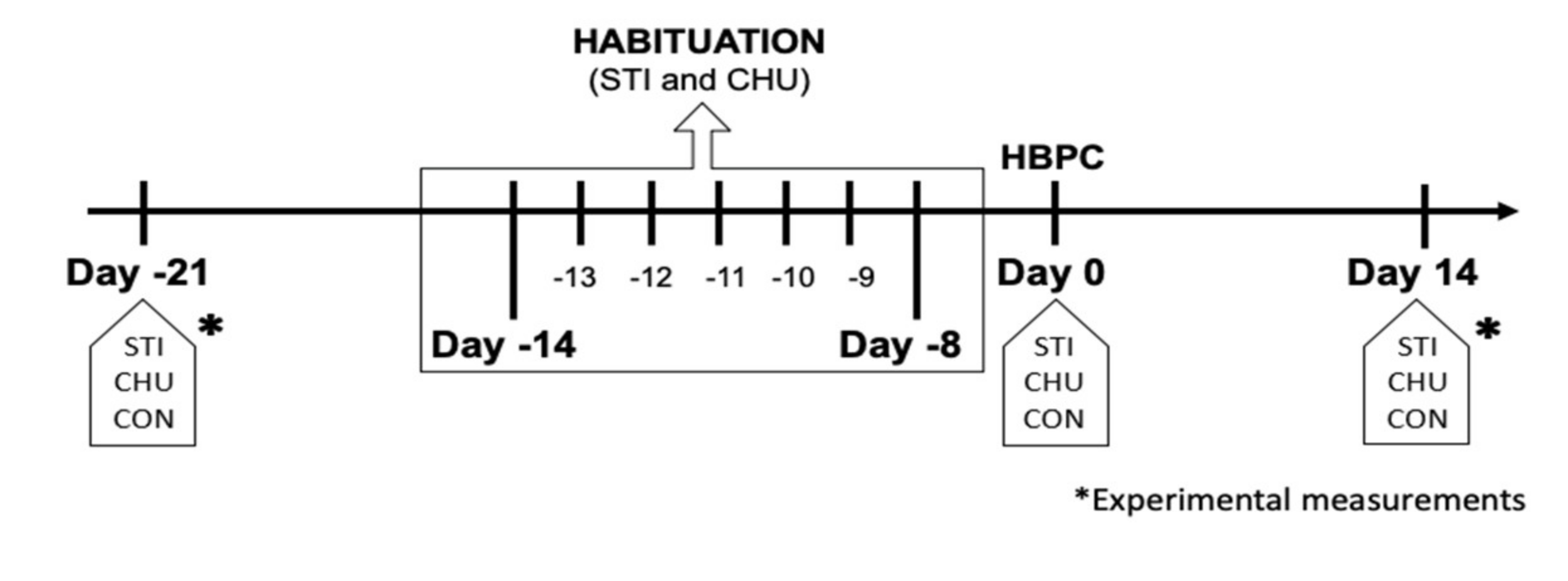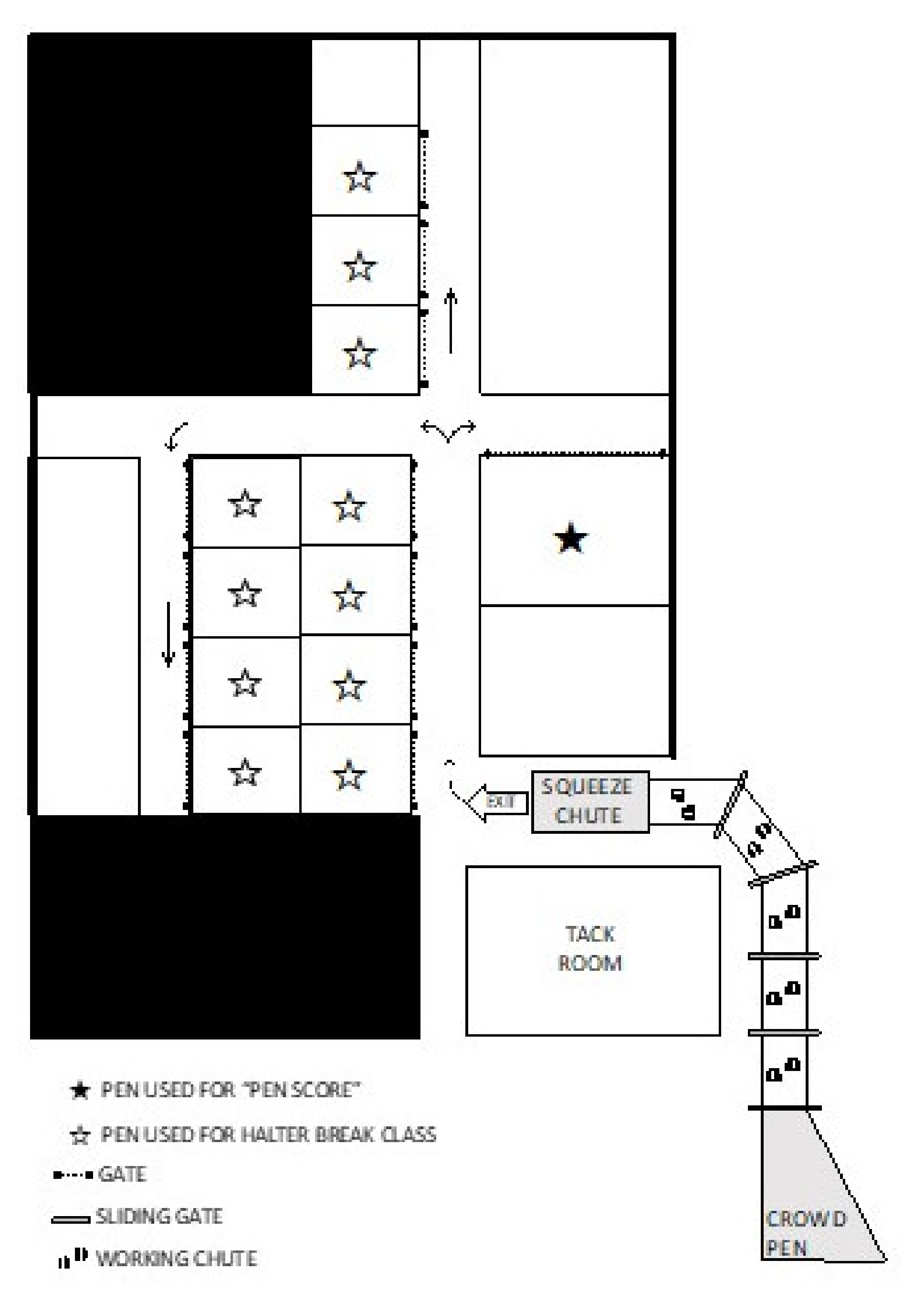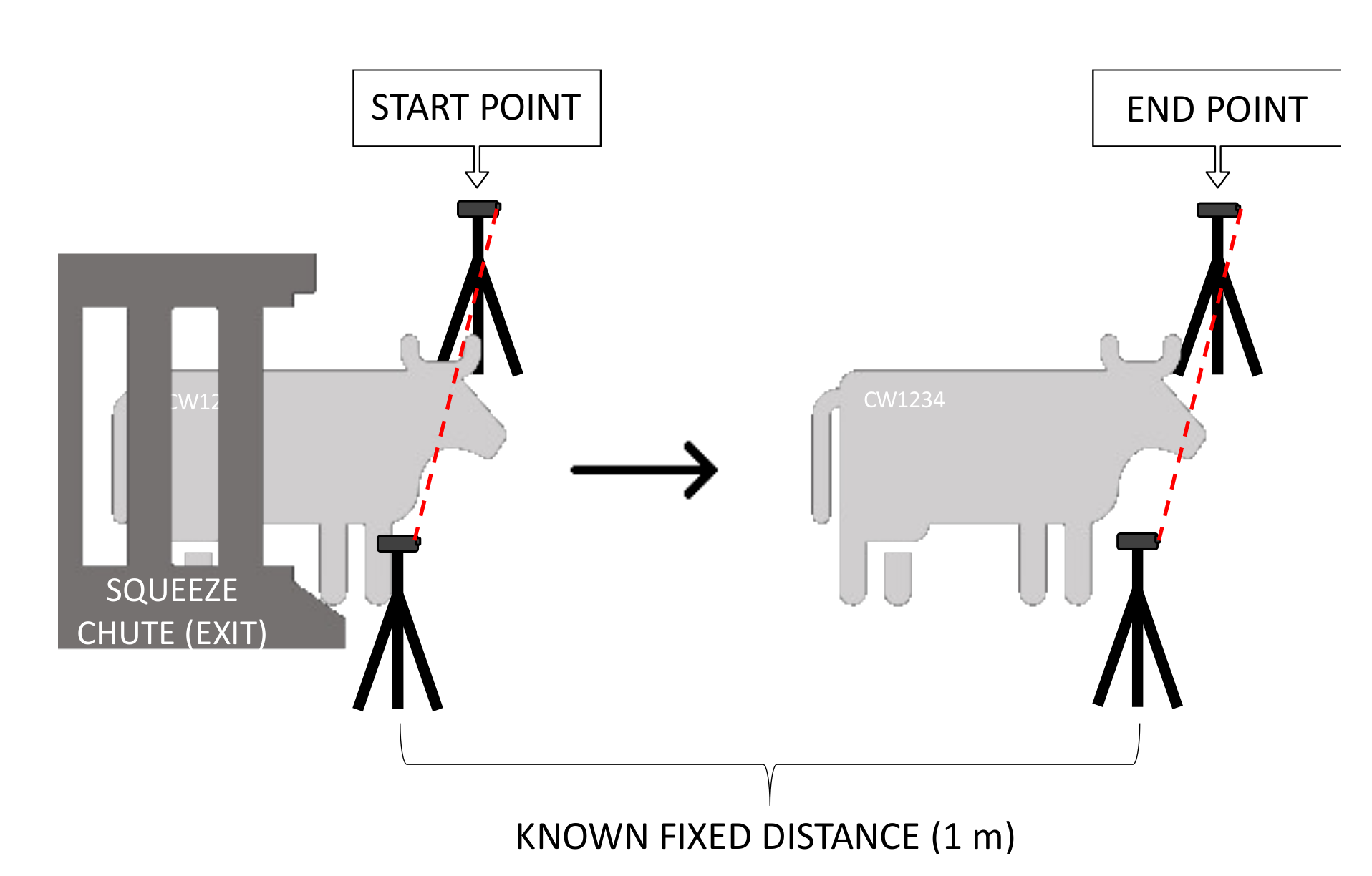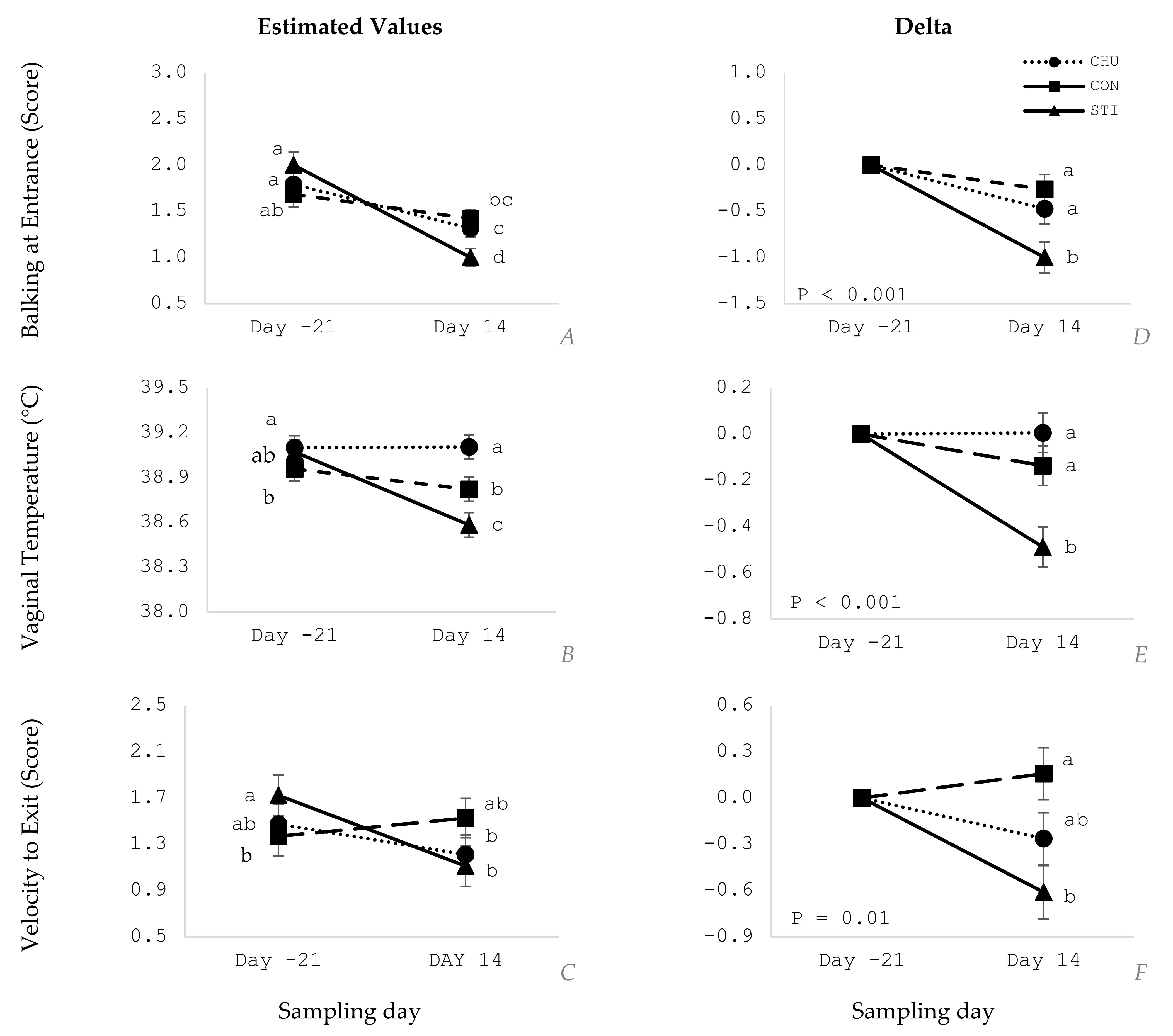Habituation Protocols Improve Behavioral and Physiological Responses of Beef Cattle Exposed to Students in an Animal Handling Class
Abstract
:Simple Summary
Abstract
1. Introduction
2. Materials and Methods
2.1. Experimental Treatments
2.1.1. Tactile Stimulation (STI Group)
2.1.2. Passage through the Chute (CHU Group)
2.1.3. Control (CON Group)
2.1.4. Halter Breaking Practice Class (HBPC)
- Stage 1: the student brought the animal through the working chute and into the squeeze chute for rope halter placement, which was performed by the student.
- Stage 2: the student trailed the animal from the squeeze chute to the respective box stall (Figure 1), allowing the animal to move freely (dragging the halter‘s rope without any tension from the student).
- Stage 3: the student tied the animal to the fence inside a box stall as part of halter habituation. The student did not interact with the heifer for 5 min. Thereafter, the student scratched the animal with a long wooden stick with a small hook at the tip (often called a show stick). The scratching continued during the remainder of the class, but only the first two minutes were evaluated.
- Stage 4: After being haltered for approximately 30 min, the student led the animal to exit the box stall and enter the pasture.
2.2. Experimental Measurements
2.2.1. Respiratory Rate and Vaginal Internal Temperature
2.2.2. Cortisol Concentration in Blood Plasma
2.2.3. Behavioral Parameters in the Working Chute
2.2.4. Behavioral Measurements in the Holding Pen
2.3. Statistical Analysis
3. Results
3.1. Behavioral Indicators
Physiological Parameters
3.2. Student-Animal Interaction during HBPC
4. Discussion
Student-Animal Interaction during HBPC
5. Conclusions
Author Contributions
Funding
Institutional Review Board Statement
Data Availability Statement
Acknowledgments
Conflicts of Interest
References
- Réale, D.; Reader, S.M.; Sol, D.; McDougall, P.T.; Dingemanse, N.J.; Sol, D.; RMcDougall, P.T.; Eader, S.M. Integrating animal temperament within ecology and evolution. Biol. Rev. 2007, 82, 291–318. [Google Scholar] [CrossRef] [PubMed] [Green Version]
- Ujita, A.; Ribeiro Vicentini, R.; Pereira Lima, M.L.; Negrão, J.A.; de Oliveira Fernandes, L.; Penido Oliveira, A.; Veroneze, R.; El Faro Zadra, L. Improvements in the behaviour of Gir dairy cows after training with brushing. J. Appl. Anim. Res. 2020. [Google Scholar] [CrossRef]
- Probst, J.K.; Hillmann, E.; Leiber, F.; Kreuzer, M.; Spengler Neff, A. Influence of gentle touching applied few weeks before slaughter on avoidance distance and slaughter stress in finishing cattle. Appl. Anim. Behav. Sci. 2013, 144, 14–21. [Google Scholar] [CrossRef]
- Probst, J.K.; Spengler Neff, A.; Leiber, F.; Kreuzer, M.; Hillmann, E. Gentle touching in early life reduces avoidance distance and slaughter stress in beef cattle. Appl. Anim. Behav. Sci. 2012, 139, 42–49. [Google Scholar] [CrossRef]
- Haskell, M.J.; Simm, G.; Turner, S.P. Genetic selection for temperament traits in dairy and beef cattle. Front. Genet. 2014, 5, 1–18. [Google Scholar] [CrossRef]
- Kolb, D.A. Experiential Learning- Experience as the Source of Learning and Development, 2nd ed.; Prentice-Hall: Hoboken, NJ, USA, 2015; ISBN ISBN 9788578110796. [Google Scholar]
- Wulff-Risner, L.; Stewart, B. Using Experiential Learning To Teach Evaluation Skills. J. Agric. Educ. 1997. [Google Scholar] [CrossRef] [Green Version]
- Munksgaard, L.; DePassillé, A.M.; Rushen, J.; Herskin, M.S.; Kristensen, A.M. Dairy cows’ fear of people: Social learning, milk yield and behaviour at milking. Appl. Anim. Behav. Sci. 2001, 73, 15–26. [Google Scholar] [CrossRef]
- Breuer, K.; Hemsworth, P.H.; Coleman, G.J. The effect of positive or negative handling on the behavioural and physiological responses of nonlactating heifers. Appl. Anim. Behav. Sci. 2003, 84, 3–22. [Google Scholar] [CrossRef]
- Brouček, J.; Uhrinčat, M.; ŠoCh, M.; Kišac, P.; UhRinČať, M.; ŠoCh, M.; Kišac, P. Genetics of behaviour in cattle. Slovak J. Anim. Sci. 2008, 41, 166–172. [Google Scholar] [CrossRef]
- Doerfler, R.L.; Lehermeier, C.; Kliem, H.; Möstl, E.; Bernhardt, H. Physiological and behavioral responses of dairy cattle to the introduction of robot scrapers. Front. Vet. Sci. 2016, 3, 1–11. [Google Scholar] [CrossRef] [PubMed] [Green Version]
- Ujita, A.; El Faro, L.; Vicentini, R.R.; Pereira Lima, M.L.; de Oliveira Fernandes, L.; Oliveira, A.P.; Veroneze, R.; Negrão, J.A. Effect of positive tactile stimulation and prepartum milking routine training on behavior, cortisol and oxytocin in milking, milk composition, and milk yield in Gyr cows in early lactation. Appl. Anim. Behav. Sci. 2021. [Google Scholar] [CrossRef]
- Becker, B.G.; Lobato, J.F.P. Effect of gentle handling on the reactivity of zebu crossed calves to humans. Appl. Anim. Behav. Sci. 1997, 53, 219–224. [Google Scholar] [CrossRef]
- Silva, L.P.; Sant’Anna, A.C.; Silva, L.C.M.; da Costa, M.J.R.P. Long-term effects of good handling practices during the pre-weaning period of crossbred dairy heifer calves. Trop. Anim. Health Prod. 2017, 49, 153–162. [Google Scholar] [CrossRef] [Green Version]
- Lürzel, S.; Windschnurer, I.; Futschik, A.; Waiblinger, S. Gentle interactions decrease the fear of humans in dairy heifers independently of early experience of stroking. Appl. Anim. Behav. Sci. 2016, 178, 16–22. [Google Scholar] [CrossRef]
- Lee, C.; Cafe, L.M.; Robinson, S.L.; Doyle, R.E.; Lea, J.M.; Small, A.H.; Colditz, I.G. Anxiety influences attention bias but not flight speed and crush score in beef cattle. Appl. Anim. Behav. Sci. 2018, 205, 210–215. [Google Scholar] [CrossRef]
- Burdick Sanchez, N.C.; Carroll, J.A.; Randel, R.D.; Vann, R.C.; Welsh, T.H. Associations between endotoxin-induced metabolic changes and temperament in Brahman bulls. J. Anim. Physiol. Anim. Nutr. (Berl). 2014, 98, 178–190. [Google Scholar] [CrossRef]
- Crowder, M.J.; Hand, D.J. Analysis of Repeated Measures; Chapman and Hall: London, UK, 1990; ISBN 0-412-318390-X. [Google Scholar]
- Laurence, M.; Barnes, A.; Collins, T.; Hyndman, T.; Musk, G.C. Assessing and mitigating post-operative castration pain in Bos indicus cattle. Anim. Prod. Sci. 2016, 58, 909–919. [Google Scholar] [CrossRef]
- Lima, M.L.P.; Negrão, J.A.; de Paz, C.C.P.; Grandin, T. Minor corral changes and adoption of good handling practices can improve the behavior and reduce cortisol release in Nellore cows. Trop. Anim. Health Prod. 2018, 50, 525–530. [Google Scholar] [CrossRef]
- Maçal-Pedroza, M.G.; Campos, M.M.; Pereira, L.G.R.; Machado, F.S.; Tomich, T.R.; da Costa, M.J.R.P.; Sant’Anna, A.C. Consistency of temperament traits and their relationships with milk yield in lactating primiparous F1 Holstein - Gyr cows. Appl. Anim. Behav. Sci. 2019, 112061. [Google Scholar] [CrossRef]
- Kasimanickam, R.K.; Hall, J.B.; Estill, C.T.; Kastelic, J.P.; Joseph, C.; Abdel Aziz, R.L.; Nak, D. Flunixin meglumine improves pregnancy rate in embryo recipient beef cows with an excitable temperament. Theriogenology 2018, 107, 70–77. [Google Scholar] [CrossRef]
- Néri, N.R.M.; Toledo, L.M.; Acaro Júnior, I.; Ambrósio, L.A. Estimulação tátil em novilhas leiteiras: efeitos no comportamento e na produção de leite após o parto. Bol. Indústria Anim. 2016, 73, 171–179. [Google Scholar] [CrossRef] [Green Version]
- Sanger, D.J.; Joly, D. Anxiolytic drugs and the acquisition of conditioned fear in mice. Psychopharmacology (Berl). 1985. [Google Scholar] [CrossRef] [PubMed]
- Geverink, N.A.; Kappers, A.; Van De Burgwal, J.A.; Lambooij, E.; Blokhuis, H.J.; Wiegant, V.M. Effects of Regular Moving and Handling on the Behavioral and Physiological Responses of Pigs to Preslaughter Treatment and Consequences for Subsequent Meat Quality. J. Anim. Sci. 1998. [Google Scholar] [CrossRef]
- MacKay, J.R.D.; Haskell, M.J.; Deag, J.M.; van Reenen, K. Fear responses to novelty in testing environments are related to day-to-day activity in the home environment in dairy cattle. Appl. Anim. Behav. Sci. 2014. [Google Scholar] [CrossRef]
- Van Reenen, C.G.; Engel, B.; Ruis-Heutinck, L.F.M.; Van Der Werf, J.T.N.; Buist, W.G.; Jones, R.B.; Blokhuis, H.J. Behavioural reactivity of heifer calves in potentially alarming test situations: A multivariate and correlational analysis. Appl. Anim. Behav. Sci. 2004. [Google Scholar] [CrossRef]
- De Passillé, A.M.; Rushen, J.; Martin, F. Interpreting the behaviour of calves in an open-field test: a factor analysis. Appl. Anim. Behav. Sci. 1995. [Google Scholar] [CrossRef]
- Jones, R.B. Fear and adaptability in poultry: Insights, implications and imperatives. Worlds. Poult. Sci. J. 1996. [Google Scholar] [CrossRef]
- Benus, R.F.; Bohus, B.; Koolhaas, J.M.; van Oortmerssen, G.A. Heritable variation for aggression as a reflection of individual coping strategies. Experientia 1991. [CrossRef] [Green Version]
- Bondarenko, E.; Beig, M.I.; Hodgson, D.M.; Braga, V.A.; Nalivaiko, E. Blockade of the dorsomedial hypothalamus and the perifornical area inhibits respiratory responses to arousing and stressful stimuli. Am. J. Physiol. Regul. Integr. Comp. Physiol. 2015, 308. [Google Scholar] [CrossRef] [Green Version]
- Losada-Espinosa, N.; Villarroel, M.; María, G.A.; Miranda-de la Lama, G.C. Pre-slaughter cattle welfare indicators for use in commercial abattoirs with voluntary monitoring systems: A systematic review. Meat Sci. 2018, 138, 34–48. [Google Scholar] [CrossRef] [Green Version]
- Mohamed, R.A.; Abou-Ismail, U.A.; Shukry, M.; Elmoslemany, A.; Abdel-Maged, M. Effects of blindfolding and tail bending of Egyptian water buffaloes on their behavioural reactivity and physiological responses to pain induction. Vet. Anim. Sci. 2018, 5, 38–43. [Google Scholar] [CrossRef]
- Vicentini, R.R.; Montanholi, Y.R.; Veroneze, R.; Oliveira, A.P.; Lima, M.L.P.; Ujita, A.; El Faro, L. Infrared thermography reveals surface body temperature changes during proestrus and estrus reproductive phases in Gyr heifers (Bos taurus indicus). J. Therm. Biol. 2020, 92, 102662. [Google Scholar] [CrossRef]
- Wang, S.; Zhang, H.; Tian, H.; Chen, X.; Li, S.; Lu, Y.; Li, L.; Wang, D. Alterations in vaginal temperature during the estrous cycle in dairy cows detected by a new intravaginal device—a pilot study. Trop. Anim. Health Prod. 2020. [Google Scholar] [CrossRef]
- Bristow, D.J.; Holmes, D.S. Cortisol levels and anxiety-related behaviors in cattle. Physiol. Behav. 2007, 90, 626–628. [Google Scholar] [CrossRef]
- Mota-Rojas, D.; Broom, D.M.; Orihuela, A.; Velarde, A.; Napolitano, F.; Alonso-Spilsbury, M. Effects of human-animal relationship on animal productivity and welfare. J. Anim. Behav. Biometeorol. 2020. [Google Scholar] [CrossRef]
- Windschnurer, I.; Barth, K.; Waiblinger, S. Can stroking during milking decrease avoidance distances of cows towards humans? Anim. Welf. 2009, 18, 363–370. [Google Scholar]
- Curley, K.O.; Paschal, J.C.; Welsh, T.H.; Randel, R.D. Technical note: Exit velocity as a measure of cattle temperament is repeatable and associated with serum concentration of cortisol in Brahman bulls. J. Anim. Sci. 2006. [Google Scholar] [CrossRef]
- Grandin, T.; Shivley, C. How farm animals react and perceive stressful situations such as handling, restraint, and transport. Animals 2015, 5, 1233–1251. [Google Scholar] [CrossRef]
- Hakan, K.; Demirci, S. Livestock-Handling Related Injuries and Deaths. In Livestock Production; IntechOpen Limited: London, UK, 2012. [Google Scholar]
- Shahin, M. The effects of positive human contact by tactile stimulation on dairy cows with different personalities. Appl. Anim. Behav. Sci. 2018, 204, 23–28. [Google Scholar] [CrossRef]
- Müller, R.; von Keyserlingk, M.A.G. Consistency of flight speed and its correlation to productivity and to personality in Bos taurus beef cattle. Appl. Anim. Behav. Sci. 2006. [Google Scholar] [CrossRef]




| Moment | Parameter | Score | Animal’s Behavior Description | Reference |
|---|---|---|---|---|
| Working chute entry | Balk (BALK_ENT) | 1 | Entered voluntarily when the gate opens | Adapted from [2,19] |
| 2 | Entered with a voice command or light tap on the rump | |||
| 3 | A hard slap on the rump or tail twisting was required to induce the animal to enter | |||
| 4 | The animal did not enter with the techniques described above | |||
| Velocity (VEL_ENT) | 1 | Walking—Defined as a four-beat gait characterized by progression of the alternate lateral legs, i.e., each hoof takes off from and strikes the ground independently | [20] | |
| 2 | Trotting—Defined as a two-beat diagonal gait in which the legs move in diagonal pairs, but not quite simultaneously | |||
| 3 | Running—Defined as a three-beat gait in which the front hooves strike the ground, one after the other in a fast manner, followed by the rear hooves | |||
| Latency (LAT_ENT) | * | Time to enter the chute, having the body completely inside the chute | Adapted from [21] | |
| From working chute to exit | Locomotion (LOC) | 1 | Calm (quiet tail, eyes and ears), walked slowly without problem or balking | Adapted from [19,22] |
| 2 | Calm (quiet tail, eyes and ears), walked slowly and balks sometimes | |||
| 3 | Calm (quiet tail, eyes and ears), walked fast without problem or balking | |||
| 4 | Calm (quiet tail, eyes and ears), walked fast and balks sometimes | |||
| 5 | Excited (restless tail, eyes and ears), walked slowly without problem or balking | |||
| 6 | Excited (restless tail, eyes and ears), walked slowly and balks sometimes | |||
| 7 | Excited (restless tail, eyes and ears), walked fast without problem or balking | |||
| 8 | Excited (restless tail, eyes and ears), walked fast and balks sometimes | |||
| During blood sampling in squeeze chute ** | Restraint (BC) | 1 | Animal remained calm, with no movement of body or hooves, during blood sampling | [20] |
| 2 | Animal moved its head and body gently during blood sampling | |||
| 3 | Animal moved a lot, including movement of the hooves, and gently displaced the body | |||
| 4 | Animal moved briskly, shaking the body a lot, and moving the hooves simultaneously | |||
| 5 | Was struggling to escape—Animal was panicky or infuriated and struggles all the time to escape from the restraint during blood sampling | |||
| Squeeze chute exit | Balk (BALK_EXT) | 1 | Exited voluntarily when the gate opens | Adapted from [2,19] |
| 2 | Exited with a voice command or light tap on the rump | |||
| 3 | A hard slap on the rump or tail twisting was required to induce the animal to exit | |||
| 4 | The animal did not exit with the techniques described above | |||
| Velocity (VEL_EXT) | 1 | Walking—Defined as a four-beat gait characterized by progression of the alternate lateral legs, i.e., each hoof takes off from and strikes the ground independently | [20] | |
| 2 | Trotting—Defined as a two-beat diagonal gait in which the legs move in diagonal pairs, but not quite simultaneously | |||
| 3 | Running—Defined as a three-beat gait in which the front hooves strike the ground, one after the other in a fast manner, followed by the rear hooves | |||
| Flight time(FT) | *** | Time taken to cut two pairs of electric eyes recorded electronically in the chute exit | [16] |
| Human-Animal Interaction Description | Parameter | Score | Animal’s Behavior Description |
|---|---|---|---|
| Student haltered the heifer in the squeeze chute | Reaction to haltering | 1 | Calm, easy to halter the animal |
| 2 | Excited (alert), but still, being easy to halter the animal | ||
| 3 | Excited (alert), moving the head gently away, but easy to halter | ||
| 4 | Excited (alert), moving the head gently away, but difficult to halter | ||
| 5 | Excited (alert), moving the head abruptly away, but easy to halter | ||
| 6 | Excited (alert), moving the head abruptly away, but difficult to halter | ||
| Student conducted the animal from the squeeze chute to the pen | Velocity when leaving the squeeze chute | 1 | Walking calmly |
| 2 | Walking excited or fast | ||
| 3 | Trotting or running | ||
| Velocity when entered the pen | 1 | Walking calmly | |
| 2 | Walking excited or fast | ||
| 3 | Trotting or running | ||
| Student tied the halter’s rope of the animal to the pen’s fence | Reaction during first 5 min after tied | 1 | Standing still |
| 2 | Pulling few times for the first seconds | ||
| 3 | Pulling few times for a long time, but pulled less than 5 times | ||
| 4 | Pulling and was struggling to escape all the time | ||
| 5 | Pulling and was struggling to escape all the time; laying or turning the neck but not necessary to untie | ||
| 6 | Pulling and was struggling to escape all the time; laying or turning the neck being necessary to untie | ||
| Pulling behavior | - | How many times the animal pulled the rope during five minutes observation | |
| Student started the tactile stimulation with the show stick | Reaction during two minutes when scratching started | 1 | Calm |
| 2 | Excited (wagging the tail and/or moving the body) during approach, but soon calmed down | ||
| 3 | Excited, wagging the tail all the time, but standing still | ||
| 4 | Excited, wagging the tail, displacing the body once or twice | ||
| 5 | Excited, wagging the tail, displacing the body all the time | ||
| Student conducted the animal from the box stall to the pasture field | Velocity when left the pen | 1 | Walking calmly |
| 2 | Walking exited or fast | ||
| 3 | Trotting or running |
| Score | Animal Behavior Description |
|---|---|
| 1 | Very docile, approached the observer by itself (measured in the first minute after entering the pen). |
| 2 | Docile, did not react to the observer movements and allowed him/she to approach, even touch. |
| 3 | Docile, did not react to the observer movements and allowed him/she to approach but not to touch. |
| 4 | Slightly flighty, was aware of the observer and likely stand in a corner away from the observer. |
| 5 | Moved away from the observer and run with a raised head alongside the fence, fully aware of the observer’s position. |
| 6 | Flighty and was aware of the observer, may run along the fence or even run into gates or fences. |
| 7 | Very flighty, often called ‘crazy’ and often run at gates, fences and humans in an attempt to exit the pen. |
| Trait | Unit | STI (n = 18) | CHU (n = 19) | CON (n = 19) | DAY −21 (n = 56) | DAY 14 (n = 56) | p-Value | ||
|---|---|---|---|---|---|---|---|---|---|
| TRT | DAY | TRT ∗ DAY | |||||||
| BALK_ENT | Score | 1.50 ± 0.09 | 1.55 ± 0.08 | 1.55 ± 0.08 | 1.82 ± 0.08 | 1.25 ± 0.05 | 0.88 | <0.0001 | 0.01 |
| LAT_ENT | Seconds | 2.03 ± 0.26 a | 2.99 ± 0.24 b | 1.92 ± 0.26 a | 2.00 ± 0.18 | 2.63 ± 0.24 | 0.01 | 0.04 | 0.24 |
| VEL_ENT | Score | 1.06 ± 0.07 | 1.13 ± 0.07 | 1.16 ± 0.07 | 1.23 ± 0.05 | 1.00 ± 0.05 | 0.54 | <0.01 | 0.54 |
| LOC | Score | 4.69 ± 0.33 | 4.71 ± 0.32 | 5.45 ± 0.32 | 4.69 ± 0.27 | 5.21 ± 0.27 | 0.18 | 0.17 | 0.13 |
| RR | Respiratory cycles/minute | 44.00 ± 1.53 | 43.80 ± 1.51 | 46.63 ± 1.49 | 47.02 ± 1.24 | 42.60 ± 1.23 | 0.34 | 0.01 | 0.35 |
| VAGT | °C | 38.83 ± 0.06 a | 39.10 ± 0.06 b | 38.89 ± 0.06 a | 39.04 ± 0.05 | 38.84 ± 0.05 | <0.01 | <0.01 | 0.01 |
| BC | Score | 1.72 ± 0.16 a | 1.24 ± 0.16 b | 1.87 ± 0.16 a | 1.93 ± 0.17 | 1.29 ± 0.07 | 0.02 | <0.01 | 0.62 |
| CORT | µg/dL | 1.94 ± 0.20 | 1.94 ± 0.19 | 2.34 ± 0.19 | 2.63 ± 0.16 | 1.52 ± 0.10 | 0.25 | <0.0001 | 0.37 |
| BALK_EXT | Score | 1.19 ± 0.10 | 1.21 ± 0.10 | 1.18 ± 0.10 | 1.32 ± 0.10 | 1.07 ± 0.03 | 0.98 | 0.02 | 0.64 |
| VEL_EXT | Score | 1.42 ± 0.15 | 1.34 ± 0.15 | 1.45 ± 0.15 | 1.52 ± 0.10 | 1.28 ± 0.10 | 0.88 | 0.02 | 0.01 |
| FT | Seconds/meter | 1.42 ± 0.13 | 1.84 ± 0.14 | 1.58 ± 0.14 | 1.52 ± 0.11 | 1.71 ± 0.11 | 0.08 | 0.25 | 0.27 |
| PS | Score | 4.11 ± 0.17 | 4.24 ± 0.16 | 4.34 ± 0.16 | 4.57 ± 0.14 | 3.89 ± 0.14 | 0.62 | <0.01 | 0.21 |
| Trait | STI | CHU | CON | p-Value |
|---|---|---|---|---|
| (n = 16) | (n = 17) | (n = 16) | ||
| HALTER | 2.63 ± 0.34 b | 3.50 ± 0.36 ab | 4.38 ± 0.34 a | p < 0.01 |
| CH_EXT_VEL | 1.81 ± 0.18 | 1.88 ± 0.18 | 2.00 ± 0.18 | 0.76 |
| PEN_ENT_VEL | 1.81 ± 0.21 | 1.88 ± 0.21 | 1.88 ± 0.21 | 0.97 |
| PULL_N | 8.13 ± 3.64 | 17.24 ± 3.53 | 16.31 ± 3.64 | 0.16 |
| FIVEMIN | 3.13 ± 0.25 | 3.24 ± 0.24 | 3.00 ± 0.25 | 0.80 |
| SCRATCH | 2.75 ± 0.32 | 2.82 ± 0.31 | 3.63 ± 0.32 | 0.11 |
| PEN_EXT_VEL | 1.69 ± 0.18 a | 1.80 ± 0.18 a | 1.13 ± 0.18 b | 0.02 |
Publisher’s Note: MDPI stays neutral with regard to jurisdictional claims in published maps and institutional affiliations. |
© 2021 by the authors. Licensee MDPI, Basel, Switzerland. This article is an open access article distributed under the terms and conditions of the Creative Commons Attribution (CC BY) license (https://creativecommons.org/licenses/by/4.0/).
Share and Cite
Ujita, A.; Seekford, Z.; Kott, M.; Goncherenko, G.; Dias, N.W.; Feuerbacher, E.; Bergamasco, L.; Jacobs, L.; Eversole, D.E.; Negrão, J.A.; et al. Habituation Protocols Improve Behavioral and Physiological Responses of Beef Cattle Exposed to Students in an Animal Handling Class. Animals 2021, 11, 2159. https://doi.org/10.3390/ani11082159
Ujita A, Seekford Z, Kott M, Goncherenko G, Dias NW, Feuerbacher E, Bergamasco L, Jacobs L, Eversole DE, Negrão JA, et al. Habituation Protocols Improve Behavioral and Physiological Responses of Beef Cattle Exposed to Students in an Animal Handling Class. Animals. 2021; 11(8):2159. https://doi.org/10.3390/ani11082159
Chicago/Turabian StyleUjita, Aska, Zachary Seekford, Michelle Kott, Guillermo Goncherenko, Nicholas W. Dias, Erica Feuerbacher, Luciana Bergamasco, Leonie Jacobs, Dan E. Eversole, João A. Negrão, and et al. 2021. "Habituation Protocols Improve Behavioral and Physiological Responses of Beef Cattle Exposed to Students in an Animal Handling Class" Animals 11, no. 8: 2159. https://doi.org/10.3390/ani11082159
APA StyleUjita, A., Seekford, Z., Kott, M., Goncherenko, G., Dias, N. W., Feuerbacher, E., Bergamasco, L., Jacobs, L., Eversole, D. E., Negrão, J. A., & Mercadante, V. R. G. (2021). Habituation Protocols Improve Behavioral and Physiological Responses of Beef Cattle Exposed to Students in an Animal Handling Class. Animals, 11(8), 2159. https://doi.org/10.3390/ani11082159






